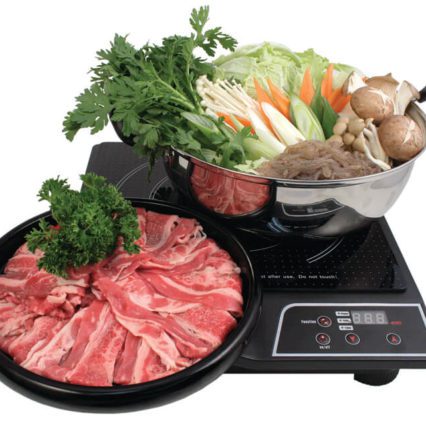How to Use a Hot Pot

In many ways, hot pots exemplify all the best things that food brings to our lives. They’re warming, socially engaging, comforting, nutritious (or, the food inside them is), and, most of all, tasty.
While the term “hot pot” often refers to the Chinese variety of this style of cooking, the method itself exists throughout East and Southeast Asia. Pretty much all of these different cuisines have their own version of stew, soup, or broth cooked and consumed — often communally —in a big shared pot. Often, these pots are earthenware of some kind, but you’ll also find ones that are cast iron, another metal, or something else depending on the cuisine and dish.
Other than the famous, regionally diverse Chinese hot pot cooking, we also love the Japanese and Korean versions of this philosophy. The Japanese variety is called “nabe,” which refers to various types of soups and stews cooked in the hot pot style. Korean jeongol is similarly warming and delicious. And then there’s the varieties in Southeast Asia! There’s so many of these, we could go much more in-depth on them including how the actual pot utensil itself varies from cuisine to cuisine, but we’ll save that for its own post later.
While we suppose one could attempt to eat all of one of these dishes themselves, one of the main components to hot pot dishes no matter where from is how they’re eaten communally. That’s a huge part of what makes hot pot meals not just tasty, but a fulfilling boost to your mental and physical health. We especially love them on a cold evening in winter or late fall; the darkness and chill of November or December could never defeat you when it gives you an excuse to see friends and share the experience of a soul-warming meal.
Using hot pot
Like we previously discussed, there’s no one “hot pot” dish. Because of that, it’s hard — nay, impossible — to say “here’s the recipe for hot pot!”
What doesn’t change from dish to dish? A great broth. And great stuff in the broth, no matter the technique. This is true whether you’re enjoying Japanese shabu shabu, Chinese instant-boiled mutton, or any of China, Japan, and the rest of East Asia’s other varieties.
Shabu shabu is a good baseline example of hot pot; first, broth is heated to a boil before being brought down to a simmer. From there, diners cook their ingredients — typically thinly-sliced beef, although other ingredients are often present too — by swishing them in the simmering broth until done. As is generally true with hot pot dishes, the cook time is quite short due to how thin the meat is; if you submerge the beef in the broth for too long, it will become tough instead of the desired succulent and tender. It’s then common to dip your cooked ingredients in other condiments or sauces like ponzu before eating.
While the traditional ingredients vary by cuisine and hot pot dish, there’s lots of different ingredients that can be cooked this way or in other hot pot methods. Thinly-sliced meat is obviously a common sight and we carry a variety of different thinly sliced meats inclusing pork, beef and chicken that we slice in house. Some hot pot varieties include seafood, too; shellfish in particular is ideal. Then there’s the vegetables (and, technically, fungi, since mushrooms are a popular addition in lots of Japanese hot pot dishes). Chinese cabbage, bok choy, and other leafy greens are rightfully popular, as is tofu. These ingredients are far from comprehensive, however. If you had a different hot pot each day of the year, you’d come across a bunch of different ingredients!
Just as methods and ingredients differ, so do the broths that complete them. Depending on the type of hot pot, you could see spicy broth, sour broth, rich broth, light broth, dashi konbu broth, earthy mushroom broth, floral broth, or just water. We carry a variety of ready made soup bases including some from popular hot pot chains Little Sheep and Hai Di Lao.
In other words, if you can only know one thing about hot pot it should be: there’s endless varieties, and they’re all awesome.




